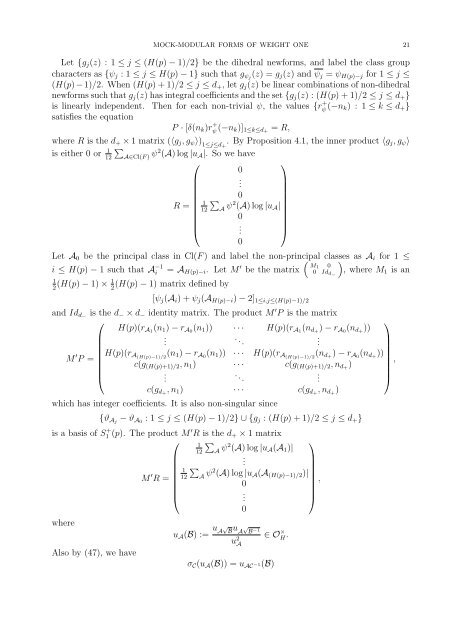Mock-modular forms of weight one - UCLA Department of Mathematics
Mock-modular forms of weight one - UCLA Department of Mathematics
Mock-modular forms of weight one - UCLA Department of Mathematics
Create successful ePaper yourself
Turn your PDF publications into a flip-book with our unique Google optimized e-Paper software.
MOCK-MODULAR FORMS OF WEIGHT ONE 21<br />
Let {g j (z) : 1 ≤ j ≤ (H(p) − 1)/2} be the dihedral new<strong>forms</strong>, and label the class group<br />
characters as {ψ j : 1 ≤ j ≤ H(p) − 1} such that g ψj (z) = g j (z) and ψ j = ψ H(p)−j for 1 ≤ j ≤<br />
(H(p) − 1)/2. When (H(p) + 1)/2 ≤ j ≤ d + , let g j (z) be linear combinations <strong>of</strong> non-dihedral<br />
new<strong>forms</strong> such that g j (z) has integral coefficients and the set {g j (z) : (H(p) + 1)/2 ≤ j ≤ d + }<br />
is linearly independent. Then for each non-trivial ψ, the values {r + ψ (−n k) : 1 ≤ k ≤ d + }<br />
satisfies the equation<br />
P · [δ(n k )r + ψ (−n k)] 1≤k≤d+ = R,<br />
where R is the d + × 1 matrix (〈g j , g ψ 〉) 1≤j≤d+<br />
. By Proposition 4.1, the inner product 〈g j , g ψ 〉<br />
∑<br />
is either 0 or 1<br />
12 A∈Cl(F ) ψ2 (A) log |u A |. So we have<br />
⎛<br />
⎞<br />
0.<br />
∑<br />
0<br />
1<br />
R =<br />
12 A ψ2 (A) log |u A |<br />
⎜<br />
⎟<br />
⎝<br />
0. ⎠<br />
0<br />
Let A 0 be the principal class in Cl(F ) and label the non-principal ( classes as A i for 1 ≤<br />
i ≤ H(p) − 1 such that A −1 = A H(p)−i . Let M ′ M1 0<br />
be the matrix 0 Id d−<br />
), where M 1 is an<br />
i<br />
1<br />
(H(p) − 1) × 1 (H(p) − 1) matrix defined by<br />
2 2<br />
[ψ j (A i ) + ψ j (A H(p)−i ) − 2] 1≤i,j≤(H(p)−1)/2<br />
and Id d− is the d − × d − identity matrix. The product M ′ P is the matrix<br />
⎛<br />
⎞<br />
H(p)(r A1 (n 1 ) − r A0 (n 1 )) · · · H(p)(r A1 (n d+ ) − r A0 (n d+ ))<br />
. .<br />
.. .<br />
M ′ H(p)(r<br />
P =<br />
A(H(p)−1)/2 (n 1 ) − r A0 (n 1 )) · · · H(p)(r A(H(p)−1)/2 (n d+ ) − r A0 (n d+ ))<br />
,<br />
c(g<br />
⎜<br />
(H(p)+1)/2 , n 1 ) · · · c(g (H(p)+1)/2 , n d+ )<br />
⎝<br />
. ⎟<br />
.<br />
.. .<br />
⎠<br />
c(g d+ , n 1 ) · · · c(g d+ , n d+ )<br />
which has integer coefficients. It is also non-singular since<br />
{ϑ Aj − ϑ A0 : 1 ≤ j ≤ (H(p) − 1)/2} ∪ {g j : (H(p) + 1)/2 ≤ j ≤ d + }<br />
is a basis <strong>of</strong> S 1 + (p). The product M ′ R is the d + × 1 matrix<br />
⎛ ∑<br />
A ψ2 (A) log |u A (A 1 )|<br />
where<br />
Also by (47), we have<br />
M ′ R =<br />
⎜<br />
⎝<br />
1<br />
12<br />
1<br />
12<br />
⎞<br />
∑<br />
.<br />
A ψ2 (A) log |u A (A (H(p)−1)/2 )|<br />
,<br />
⎟<br />
0.<br />
⎠<br />
0<br />
u A (B) := u A √ B u A √ B −1<br />
u 2 A<br />
σ C (u A (B)) = u AC −1(B)<br />
∈ O × H .
















